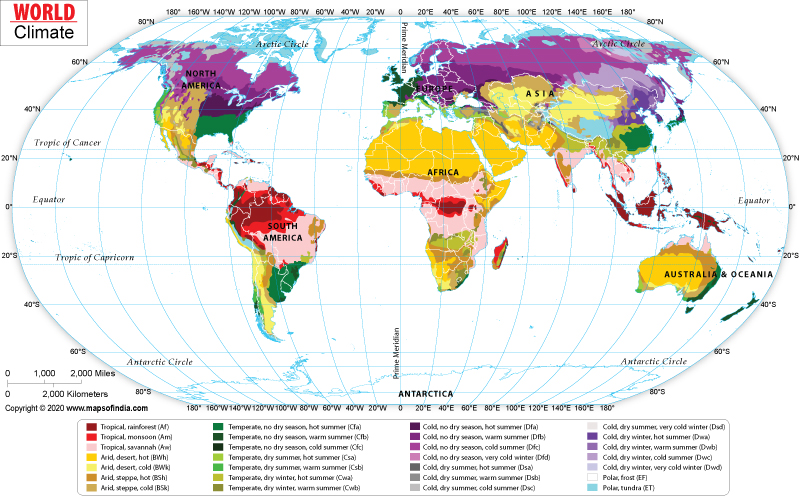The latitude, the height of the land or altitude, winds, and even the ocean currents influence the climate of a place, and because of these factors, there is a wide variation in the climate of the world. Many large countries have more than one climate, and it can also differ from city to city. Within a country, places near the coasts have a different climate as compared to those at a higher altitude.
The weather of any place is local and can vary from day to day, depending on the atmospheric conditions. For example, one day it can be extremely hot, and the next day it can be rainy. The climate of any place is its average weather conditions over a significant period. The climate of a place does not change overnight but gradually over thousands of year.
The Different Climates
This map has used the Koppen-Gieger climactic classification and lists out the main climates of the world with the variations in temperature and precipitation. According to this classification, there are five climates; Equatorial, Arid, Warm, Snow, and Polar.
The equatorial climate has very high temperatures throughout the year, with an average temperature around 18° centigrade. Some places with this climate have heavy rainfall throughout the year; some are dry in winters and others dry in summers. Most places are near the equator. Some places such as Brazil, Singapore, and the Hawaii islands in the USA are wet throughout the year. South America has a dry period in the year as the rain-bearing winds also called the monsoons change directions.
Places with Arid or desert type of climate have very little rainfall throughout the year, but the temperature can be hot or cold. Hot deserts are the Sahara and the Kalahari in Africa, the Arabian in western Asia, parts of northwest India, and parts of Australia. The Gobi desert in Mongolia and the Ladakh region of India are cold deserts.
Places near the western sides of continents have a moderate or warm climate with warm temperatures. The warmest months here have an average temperature above 10° C and the coldest 0° C. Summer months can be hot, warm, or cold, and humid or dry. Parts of countries such as Greece, Italy and Spain in Europe and Turkey in Asia have warm summers. Places such as Massachusetts and Ohio in the USA and Buenos Aires in Argentina have humid summers.
Continental climates have temperatures above 10° C in the warmest months and less than 0° C in the coldest. The places with this climate have snowfall in the coldest months. Widespread in the interiors of the continents or their east coasts. This climate occurs mostly in the northern hemisphere. Central and Eastern Europe, parts of Russia, USA, and Canada have this climate.
Polar climates have an annual average temperature below 10° C, with little rainfall, mild summers and very cold winters. This extreme climate produces a type of vegetation called Tundra. Alaska, coastal areas of Greenland, north Canada and European countries such as Norway, Finland and Sweden have a polar Tundra climate. The continent of Antarctica is under permanent ice or permafrost throughout the year.
Last Updated on : November 13, 2025

